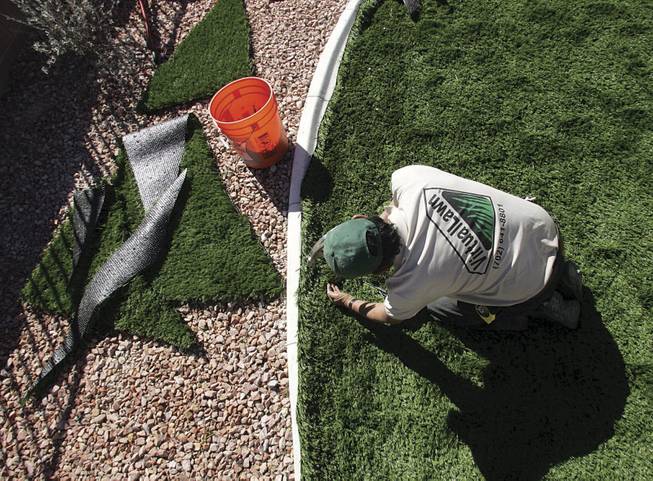
Jesus Najera installs artificial grass in February 2006. The turf can reach nearly 170 degrees, rendering it unusable, a UNLV study found.
Thursday, Jan. 15, 2009 | 2 a.m.
Artificial turf has been billed as the cure for the Las Vegas Valley’s addiction to grassy eye candy.
But while it’s water-saving prowess is unquestionable, there is a temperature problem with the emerald green lawn substitute. According to a UNLV study, fake grass can heat up to nearly 170 degrees in the warmer months.
That’s far higher than the 122 degrees that’s considered safe for sustained use by trained athletes, let alone your average toddler or family pooch.
Formerly the stuff of football fields, the realistic-looking faux blades are today more back-yard barbecue than Superdome Super Bowl, having become a popular substitute for the real version that Las Vegas water managers say strains the Southwest’s water supplies.
The turf temperature study, funded in part by the city of Las Vegas, which has 20 artificial fields, found that green artificial turf reached surface temperature highs of about 180 degrees.
“This was a temperature where if you put your hand down on it, you could only hold it for five seconds or so before it would burn,” said Dale Devitt, director of UNLV’s Center for Urban Water Conservation, who worked on the study with Mike Young of the Desert Research Institute’s Division of Hydrological Sciences.
And the study didn’t even measure temperatures during the hottest months of the year — it ran from August 2006 to March 2007.
“During the summer months, the artificial turf is not suitable for play during the day,” Devitt said.
That’s because the plastic grass with rubber fill beneath it holds onto heat. The good news is it also releases the heat quickly once the sun goes down, making it possible for athletes to play on the turf half an hour or so after clouds roll in or the sun goes down.
Still, the question remains, even if it’s saving water, is artificial turf worth the cost of installation if you can’t use it during the day for several months of the year?
Michael Rodriguez, a spokesman for the Clark County School District, says yes. He said real turf gets chewed up by heavy use during sports seasons, and that artificial turf holds up better, cuts down on maintenance and eliminates the need for most, if not all, watering.
The School District has artificial turf on four football fields.
“The downside is the temperatures are higher during the hot summer months, but a lot of times if there are activities going on during the summer months, they’re done early in the morning or later in the evening, so the heat isn’t an issue,” Rodriguez said. “Under normal circumstances you wouldn’t want your athletes out there during the hottest time of day to begin with.”
Steve Hofsaess, owner of Desert Poolscapes, agrees. His landscaping company installs faux putting greens and lawns.
“In July and August, everything is hot,” he said. “Does anyone go outside in the summer time at 120 degrees?”
And if the turf does get too hot to use, Hofsaess says, hosing it down for a few minutes solves the problem.
“That cools it down drastically,” he said.
But Devitt said watering fake grass that’s installed specifically to save water “seems like an oxymoron,” adding that as the director of the Center for Urban Water Conservation he wouldn’t advocate the practice. He said other universities have found that the false turf needs to be irrigated every 30 minutes to keep it cool enough to play on.
Rodriguez said watering the turf does more to create humidity than to cool the playing surface.
Devitt said artificial turf has some other unintended consequences as well, such as adding to the urban heat island effect, which means artificial turf, like concrete and asphalt, radiates heat back into the air at night, giving cities warmer nights. And that radiating heat also means nearby plants may need extra water, Devitt said.
“There is a place for it, to be sure, but I think there would be more of a place for it if we could get the manufacturer to look at the shortcomings and try to redesign” it, he said. “I’m sure the technology is there. There just has to be a demand for it.”

Join the Discussion:
Check this out for a full explanation of our conversion to the LiveFyre commenting system and instructions on how to sign up for an account.
Full comments policy